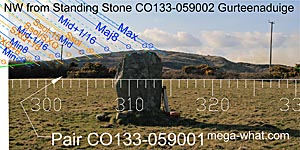An obvious step in the north-western hillslope marks both the sixteenth on the minor side of the lunar midpoint and the half-month bracket for the cross-quarter as it does from the pair. The hilltop marks 3/32 of the lunisticeLunistices are the most northerly and southerly moons of the month. The lunar equivalent of solstices - more. range away from the major standstillLunistice positions vary cyclically over an 18.6 year period but are fairly static for more than a year at either end of the range. This is a difference of 1/32 to the value obtained from the pair.
Green lines approximate hidden horizon segments.
 To the north-east is Carrig Fadda. Once again the point surveyed here as a sixteenth from the lunar standstillLunistice positions vary cyclically over an 18.6 year period but are fairly static for more than a year at either end of the range
is different from the value obtained from the pair by 1/32. This time the difference being the other way round as it is Max-3/32 from there.
This is a further indication that the Standing Stone and Pair were built to complement each other and also that they were deliberately measuring the
lunisticeLunistices are the most northerly and southerly moons of the month. The lunar equivalent of solstices - more.
range in thirtysecondths.
To the north-east is Carrig Fadda. Once again the point surveyed here as a sixteenth from the lunar standstillLunistice positions vary cyclically over an 18.6 year period but are fairly static for more than a year at either end of the range
is different from the value obtained from the pair by 1/32. This time the difference being the other way round as it is Max-3/32 from there.
This is a further indication that the Standing Stone and Pair were built to complement each other and also that they were deliberately measuring the
lunisticeLunistices are the most northerly and southerly moons of the month. The lunar equivalent of solstices - more.
range in thirtysecondths.
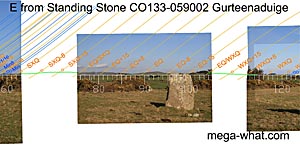 To the east, the view of the equinoctial zone is essentially the same as from the pair.
To the east, the view of the equinoctial zone is essentially the same as from the pair.
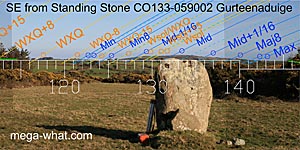 The south-east is also the same from here as from the pair, with declination differences being less than 0.1°.
This is because the positional displacement is in that direction and the horizon is fairly distant.
The south-east is also the same from here as from the pair, with declination differences being less than 0.1°.
This is because the positional displacement is in that direction and the horizon is fairly distant.
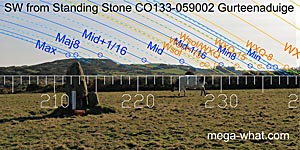 To the south-west the differences are significant but this segment is largely obscured from the pair.
From here the lunar limit is on the hilltop though once again we have the sixteenth rather than the standstillLunistice positions vary cyclically over an 18.6 year period but are fairly static for more than a year at either end of the range
itself.
To the south-west the differences are significant but this segment is largely obscured from the pair.
From here the lunar limit is on the hilltop though once again we have the sixteenth rather than the standstillLunistice positions vary cyclically over an 18.6 year period but are fairly static for more than a year at either end of the range
itself.
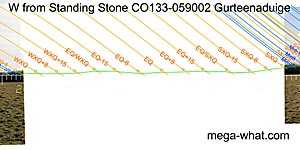 The west is obscured by a hedge.
The west is obscured by a hedge.
References
- Archaeological Survey of Ireland, record details. www.archaeology.ie/archaeological-survey-ireland
- POWER, D. et al. 1992 Archaeological Inventory of County Cork Volume 1: West Cork. Dublin: Stationary Office. p57, no.382.

